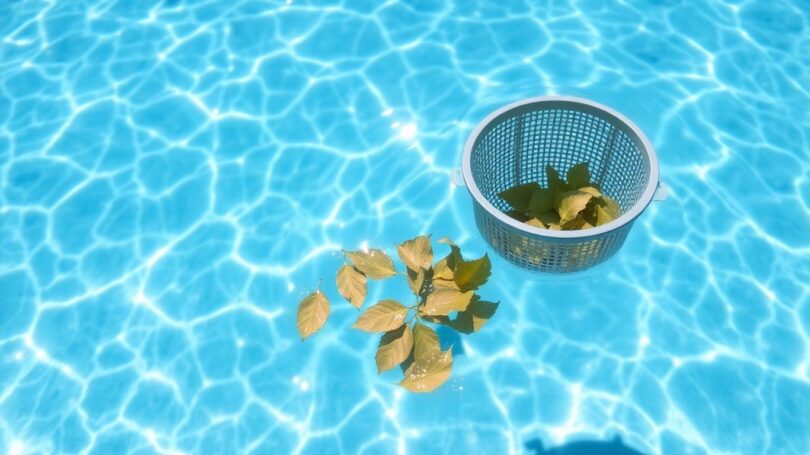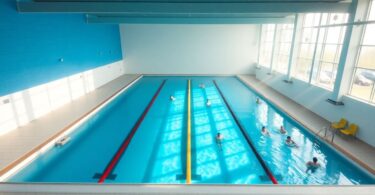G’day, fellow pool owners! If you’re keen to keep your backyard oasis sparkling clean without too much fuss, you’ve come to the right place. We’re gonna chat about how to keep your pool in tip-top shape, making sure the maintenance of a swimming pool is a breeze. It’s not as hard as you might think, and once you get the hang of it, you’ll be wondering why you didn’t start sooner. Let’s get stuck in and make that pool shine!
Key Takeaways
- Regularly looking after your pool makes it stay clean and inviting.
- Picking the right tools for the job makes a big difference.
- Getting your pool ready before you start cleaning saves headaches.
- A steady approach to cleaning gets the best results.
- Always look after your gear after each use.
Understanding What Is A Skimmer For Pool

So, what exactly is a pool skimmer, and why should you care about it? Think of it as the first line of defence for your pool’s cleanliness. It’s that little opening, usually with a basket inside, located on the side of your pool, just below the waterline. Its main job is to grab all the floating gunk – leaves, bugs, pollen, you name it – before it sinks to the bottom and becomes a real pain to clean up.
The Role Of Your Pool Skimmer
Your pool skimmer is a pretty clever bit of kit. It works with your pool’s circulation system. As the water flows, it gets drawn into the skimmer opening. This water, along with the floating debris, then heads into the skimmer basket. This basket is designed to catch the bigger bits, stopping them from clogging up your pump and filter. After passing through the basket, the water continues its journey to the pump and then through the filter, getting cleaned up before being returned to the pool. It’s a continuous cycle, and a properly functioning skimmer is key to keeping that cycle efficient. A clean skimmer basket means your pool pump doesn’t have to work as hard, which is good for its lifespan and your electricity bill. Keeping your pool water clean starts with a good pool skimmer.
Why Skimming Is Essential For A Sparkling Pool
Honestly, if you don’t skim your pool regularly, you’re asking for trouble. All that stuff floating on the surface? If left unchecked, it’ll eventually sink. Once debris hits the bottom, it starts to break down. This decomposition process uses up your pool’s sanitiser, like chlorine, and can also encourage algae growth. Plus, it just looks messy, doesn’t it? A pool covered in leaves and bugs isn’t exactly inviting. Regular skimming, even just a quick sweep with a net, makes a massive difference to how clean and appealing your pool looks. It’s a simple task that prevents bigger problems down the track.
How A Skimmer Contributes To Water Quality
Beyond just removing surface debris, your skimmer plays a bigger role in keeping your water healthy. By constantly drawing water in, it helps circulate the pool water. This circulation is vital for distributing chemicals evenly throughout the pool and preventing stagnant areas where algae and bacteria love to breed. The skimmer also helps to reduce the load on your main filter. When the skimmer basket catches the bulk of the debris, less gunk makes it to the filter, meaning your filter doesn’t clog up as quickly. This translates to cleaner water and less frequent filter cleaning or backwashing. It’s all about preventing problems before they start.
Keeping your pool water level right is also super important for the skimmer to do its job. If the water level is too low, the skimmer won’t be able to suck water in properly, and you risk sucking air into your pump, which is a big no-no.
Here’s a quick rundown of what your skimmer helps with:
- Grabs floating leaves, bugs, and other surface debris.
- Prevents debris from sinking and decomposing.
- Helps circulate pool water for even chemical distribution.
- Reduces the strain on your pool pump and filter system.
- Contributes to clearer, more inviting pool water.
Essential Pool Maintenance Gear
Alright, let’s talk about the tools of the trade for keeping your Aussie pool looking its best. It’s not just about having a pool; it’s about having a sparkling oasis, and that means having the right gear. Don’t just grab the cheapest stuff you see; think about what’s going to last in our tough climate and actually make the job easier.
Selecting The Right Skimmer Net
Your skimmer net is your first line of defence against all the leaves, bugs, and general gunk that finds its way into your pool. A good quality skimmer net will make surface cleaning a breeze. You want something with a sturdy frame that won’t bend or break after a few uses. The mesh is important too – a finer mesh will catch smaller debris, but it can clog up faster. A medium mesh is often a good compromise for general use. Think about the size of your pool and how much debris you typically get when choosing the width of the net.
Durable Materials For Aussie Conditions
This is where you really don’t want to skimp. Our sun is harsh, and cheap plastic gear just won’t cut it. Look for equipment made from UV-resistant materials. Aluminium poles are a good bet because they’re lightweight and won’t rust. For nets and brushes, reinforced plastics or even fibreglass can offer better longevity. Investing a bit more upfront in quality gear means you won’t be replacing it every season. It’s like buying good work boots; they cost more, but they last.
Choosing The Correct Pool Vacuum Head
When it comes to vacuuming, you’ve got a few choices. Manual vacuums are great for getting into corners and tackling specific spots. Automatic pool cleaners, on the other hand, can do the hard yakka for you. When picking a vacuum head, consider your pool’s surface – concrete, tile, or vinyl liner – as some heads are better suited for certain materials. The size of the head matters too; a wider head covers more ground, but a smaller one might be better for navigating steps and tight spaces. Make sure you have a compatible telescopic pole to go with it.
Getting the right tools is half the battle. A bit of research now can save you a lot of hassle and money down the track. Don’t be afraid to ask for advice at your local pool shop.
Mastering Pool Vacuuming Techniques
Right then, you’ve got your gear ready and the pool’s prepped. Now for the main event: getting that vacuum head moving and sucking up all the gunk. It’s not just about shoving it around, you know. There’s a bit of a knack to it if you want a truly sparkling result, and trust me, it makes a difference.
Preparing Your Pool For Vacuuming
Before you even think about dunking that vacuum head in, there’s some groundwork to do. Think of it like getting the barbie ready before chucking on the snags – a bit of effort now saves a whole lot of grief later. Getting everything sorted before you start vacuuming is key to a smooth, effective clean.
- Gather Your Cleaning Kit: First things first, round up all your gear. You don’t want to be halfway through and realise you’ve left your pole on the other side of the yard. You’ll need your vacuum head, a long pole, your hose (make sure it’s not kinked!), and maybe a skimmer box vacuum plate if you use one. A pool brush is also a good idea.
- Check Your Pool’s Water Level: This one’s a ripper. Before you start, have a squiz at your pool’s water level. It needs to be at the right height for your skimmer to work properly and for your pump to get a good prime. If it’s too low, you risk sucking air into your system, which is a real pain and can damage your pump. If it’s a bit low, top it up with the garden hose. Easy as that.
- Brush Down The Pool Walls: Grab your pool brush and give the walls and floor a good scrub. This knocks any loose dirt and algae off the surfaces and into the water column, making it easier for your vacuum to suck it all up. Think of it as loosening the dirt before you sweep the floor inside. Pay extra attention to those shady spots where algae loves to hang out.
The Slow And Steady Vacuuming Method
This isn’t a sprint, mate, it’s a marathon. Moving your pool vacuum head slowly and deliberately is the secret to picking up all that gunk without stirring it up. If you go too fast, you’ll just kick up the dirt and debris, turning your crystal-clear water into a cloudy mess. Then you’ll have to wait for it all to settle again, which is a right pain. Think of it like mowing the lawn – nice, even passes, no rushing.
- Start at one end: Usually, you’ll start in the shallow end and work your way towards the deep end. This gives you a good flow.
- Overlap your strokes: Just like painting a wall or mowing the lawn, you need to overlap your strokes to make sure you don’t miss any spots. Each pass should slightly overlap the previous one. This systematic approach ensures you cover every inch of the pool floor.
- Maintain consistent speed: Keep a steady, slow pace. You want to give the vacuum head time to suck up everything in its path. Patience is a virtue when you’re trying to get your pool looking its best.
Tackling Tricky Spots And Stubborn Debris
Sometimes you’ll come across a patch of stubborn gunk that just won’t budge on the first go. Don’t stress, it happens. For these tricky bits, you might need to go over them a couple of times. If it’s really stuck, you can try a slightly firmer, but still slow, push.
| Debris Type |
|—|—|
| Fine Silt | Very slow, gentle passes; may require multiple attempts. |
| Leaves | Go over slowly; if large, consider using a leaf skimmer first. |
| Algae Spots | Brush first to loosen, then vacuum slowly. |
Don’t be tempted to speed things up, or you’ll just create more work for yourself in the long run. A little bit of extra time spent now means a much cleaner pool later.
Post-Vacuuming Pool Care
So, you’ve wrestled that pool vacuum around and the bottom looks a treat. But don’t pack up your gear just yet! There are a few important steps to take after vacuuming to keep your pool looking its best and to make sure your cleaning equipment lasts.
Backwashing Your Pool Filter Like A Pro
After you’ve sucked up all that gunk, your pool filter has done a lot of heavy lifting. It’s probably clogged with all the debris you’ve removed. Backwashing is the process of flushing out this trapped dirt, which keeps your filter working efficiently. Here’s a quick rundown:
- Turn off the pool pump.
- Set the multiport valve to the ‘Backwash’ setting.
- Turn the pump back on and let it run for a couple of minutes, or until the water in the sight glass looks clear.
- Turn the pump off again.
- Switch the valve to ‘Rinse’ and run the pump for about 30 seconds.
- Turn the pump off one last time and return the multiport valve to the ‘Filter’ position.
This process gets rid of the nasties from your filter, so it can do its job properly next time. If you skip this, your filter can get blocked, meaning it won’t clean the water as well, and it could even get damaged.
Checking And Adjusting Water Chemistry
Vacuuming can sometimes stir things up a bit, so it’s a good idea to check your pool’s water balance afterwards. Grab your test kit and have a look at the pH, chlorine, and alkalinity levels. If anything’s a bit off, you’ll need to add the right chemicals to get it back in line. Keeping your water balanced is key for a sparkling pool and for protecting your equipment.
Here’s a rough guide to what you’re aiming for:
- pH: Between 7.2 and 7.8
- Chlorine: 1-3 parts per million (ppm)
- Alkalinity: 80-120 ppm
Remember, balanced water chemistry not only makes your pool look good but also stops your equipment from wearing out too quickly and keeps the water safe for swimming.
Caring For Your Pool Cleaning Equipment
Don’t just leave your vacuum head and hose lying around after you’re done. Give them a good rinse with fresh water to wash off any leftover dirt or pool chemicals. Let them dry completely before storing them somewhere cool and out of direct sunlight. This helps prevent mould and keeps your gear in good condition for longer. Coiling the hose loosely will also stop it from kinking and cracking. A little bit of care goes a long way in making your pool cleaning gear last. You can find replacement parts for your pool vacuum head if needed.
Seasonal Pool Care For Australian Pools
Spring Clean For Summer Readiness
As the weather warms up, it’s time to get your pool ready for the busy summer months. Think of this as your pool’s annual ‘spring clean’. First, give everything a good once-over. Check for any damage that might have happened over winter – look for cracks or leaks, especially around the equipment. Get any repairs sorted pronto. Then, it’s time for a deep clean. Vacuum up any settled debris, brush the walls and floor, and make sure there’s no lingering algae. Balancing your water chemistry is also super important at this stage. Test and adjust your pH, alkalinity, and sanitiser levels. A bit of effort now means a much smoother summer.
Summer Routine For Daily Sparkle
Summer is prime pool time, so consistency is key. You’ll want to test your water chemistry at least twice a week. The hot sun and increased use can really throw things out of balance quickly. Skimming the surface daily is a good habit to get into – it catches leaves, bugs, and other floating bits before they sink. Aim to vacuum at least once a week to keep the pool floor tidy. Don’t forget your filter; cleaning it regularly stops it from getting clogged, which helps your pump work better and keeps your water clearer. Running your filter for about 8 hours a day during summer is generally recommended to keep everything circulating nicely. Keeping your pool clean is more than just looks; it’s about making sure it’s safe and healthy for everyone.
Autumn Prep For Leafy Challenges
Autumn brings its own set of challenges, mainly falling leaves. These can quickly make your pool look messy and can even stain surfaces or clog up your filter. Investing in a good leaf rake or a pool cover can make a big difference. Keep an eye on your water chemistry, too. Even if you’re not swimming as much, balanced water prevents problems. If you’re thinking about closing the pool for winter, now’s the time to get a winter cover ready. It’ll protect the pool and make that spring clean-up a lot easier.
Adapting your pool care to the changing seasons is the best way to keep your backyard oasis looking its best and ready for a dip whenever the mood strikes.
Why Regular Pool Maintenance Matters

Keeping your pool looking schmick isn’t just about appearances; it’s about making sure your backyard oasis is safe, healthy, and ready for a dip whenever the Aussie sun is shining. Neglecting regular upkeep can lead to a whole heap of problems, from murky water to costly repairs down the track. Let’s get into why staying on top of your pool care is so important.
Keeping Your Backyard Oasis Inviting
Nobody wants to step outside for a refreshing swim only to find a green, scummy mess. Regular cleaning, like skimming out leaves and giving the skimmer basket a good empty, makes a huge difference. It stops debris from sinking and breaking down, which can make the water cloudy and uninviting. A quick skim each day, especially if you’ve got gum trees nearby, means you’re always ready for an impromptu dip. It’s about making sure your pool is a place you want to be, not a chore you have to deal with.
Protecting Your Pool Investment
Your pool is a big investment, and like any investment, it needs looking after. Our Aussie weather can be pretty harsh, with intense sun and sometimes dust. Regular maintenance helps protect your pool’s surfaces and equipment from these elements. Think of it as giving your pool a fighting chance against the climate. By keeping on top of things, you’ll extend the life of your pool and avoid expensive repairs later on. For instance, making sure your pool skimmer basket is clear prevents strain on your pump, saving you money and hassle.
Ensuring Safer Swimming Conditions
This is a big one. Keeping your pool water balanced is key to preventing algae and harmful bacteria. If the water chemistry is off, it can lead to skin irritations and even make people sick. Regularly testing and adjusting your pool’s water – checking things like chlorine and pH levels – ensures it’s clean, clear, and safe for everyone. A consistent routine means you can catch small issues before they become big problems, like algae blooms or equipment damage. It’s not just about looks; it’s about health and safety for your family and friends.
Here’s a quick look at what a basic routine can involve:
- Daily: Check water level, empty skimmer baskets if needed, and give the surface a quick skim.
- Weekly: Test and balance the water chemistry (pH, chlorine, alkalinity) and give the pool a brush.
- Monthly: Check filter pressure and clean or backwash as needed.
A little bit of effort spread out over time makes a massive difference. It’s much easier to spend 10-15 minutes a few times a week keeping things tidy than it is to tackle a full-blown green pool situation.
So, That’s a Wrap on Pool Skimming!
Right then, we’ve gone through the ins and outs of keeping your pool looking its best. It’s not rocket science, is it? Just a bit of regular attention, using the right gear, and knowing how to tackle the job. By sticking to these simple steps, you’ll have your pool looking grouse all year round. Less time fiddling with it, more time actually enjoying your own little piece of Aussie paradise. Happy swimming, everyone!
Frequently Asked Questions
Why is it important to clean my pool regularly?
Keeping your pool clean isn’t just about looks; it’s about making sure it’s safe and healthy for swimming. Regular cleaning stops yucky stuff like algae from growing and keeps your pool equipment working well, saving you money on repairs down the track.
What gear do I need to keep my pool clean?
You’ll need a good skimmer net to grab floating bits, a pool vacuum to suck up dirt from the bottom, and a long pole to reach everywhere. Make sure the gear you pick is tough enough for our Aussie weather, so it lasts longer.
What’s the best way to vacuum my pool?
The trick is to go slow and steady. If you rush, you’ll just stir up the dirt and make the water cloudy. Move the vacuum head smoothly across the bottom, overlapping each pass a bit so you don’t miss any spots. It’s like mowing the lawn – nice, even strokes.
What should I do after I finish vacuuming my pool?
After vacuuming, it’s a good idea to clean your pool filter by backwashing it. Then, check your pool’s water chemistry, like the chlorine and pH levels, and fix them if they’re not right. Don’t forget to rinse your cleaning gear and store it somewhere shady.
How do I get my pool ready for summer?
In spring, give your pool a good clean-out. Check for any damage from winter, scrub the walls and floor, and make sure your water chemistry is balanced. This gets it ready for all the swimming you’ll do when it heats up.
What do I do when lots of leaves fall into my pool in autumn?
Autumn means leaves! Skim the surface every day to get rid of them before they sink. You might also want to vacuum more often. Keeping on top of the leaves stops them from clogging up your filter and making the water murky.








